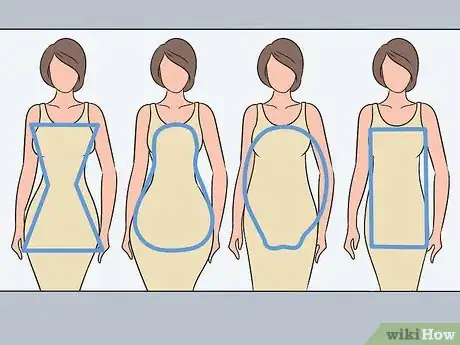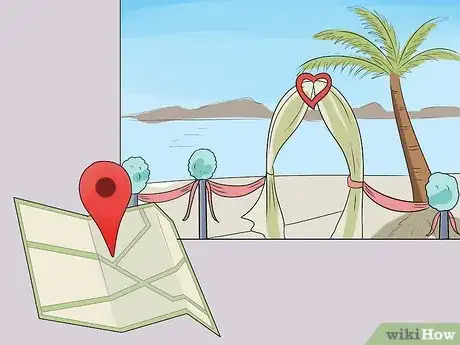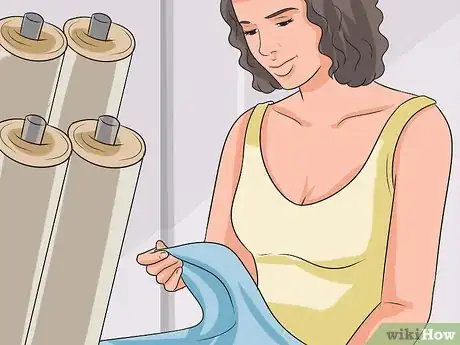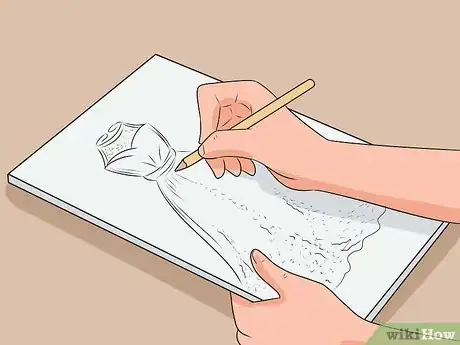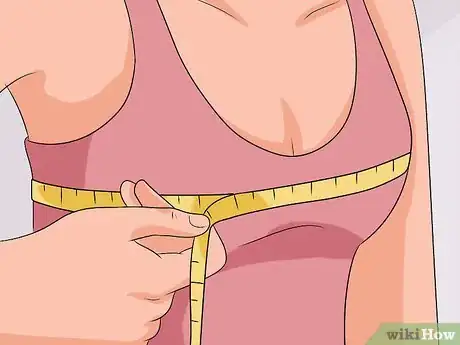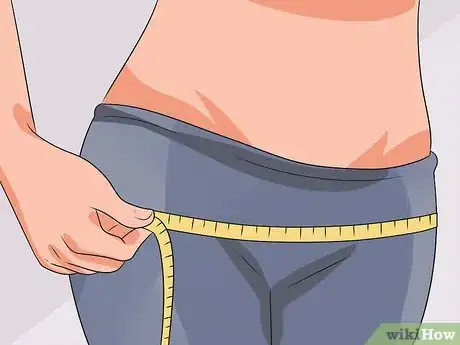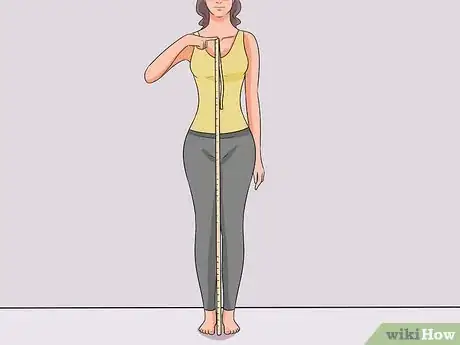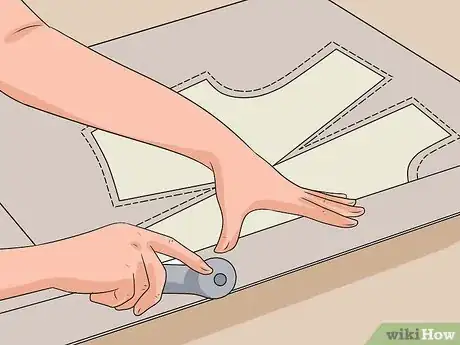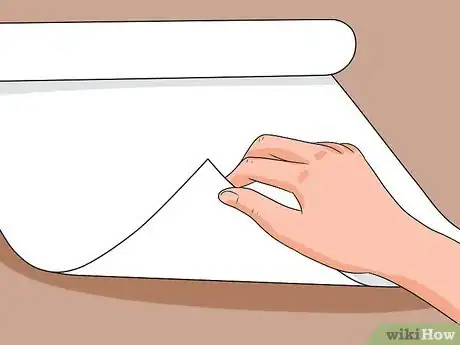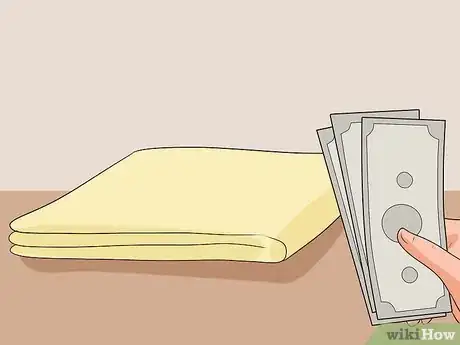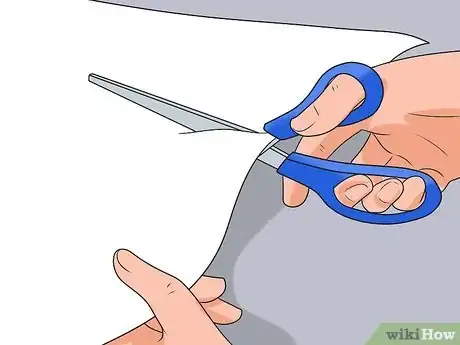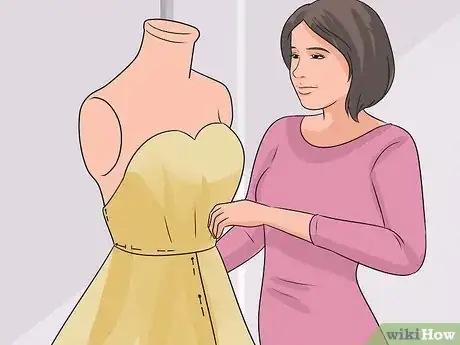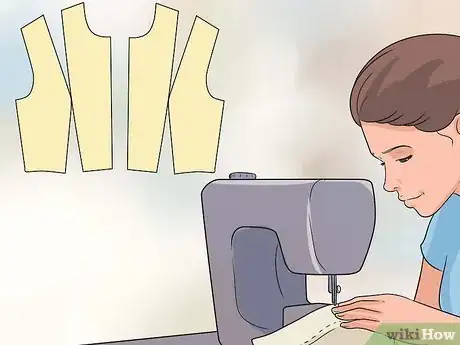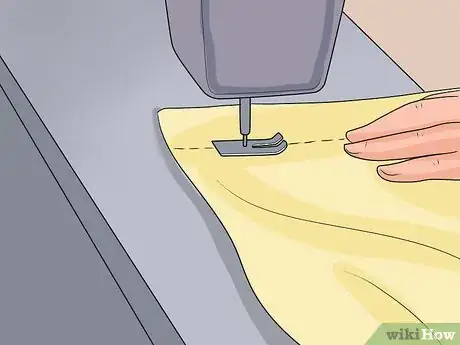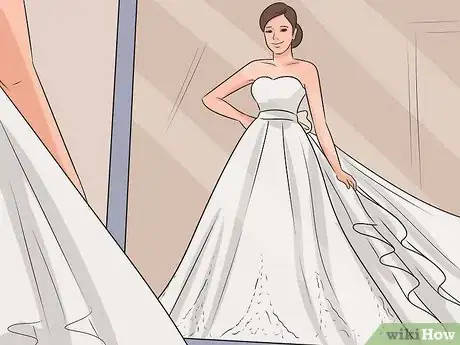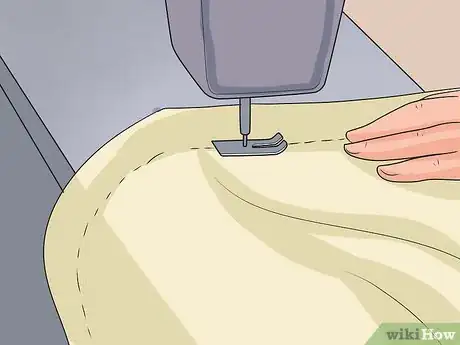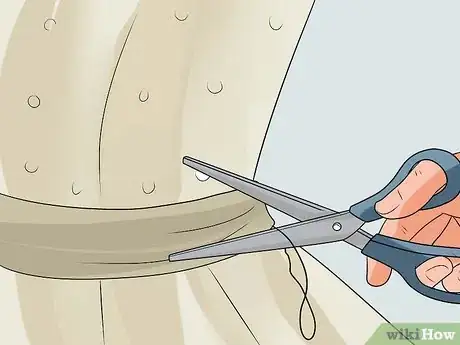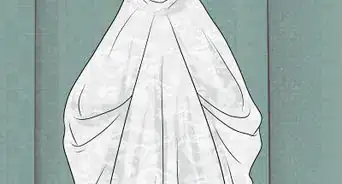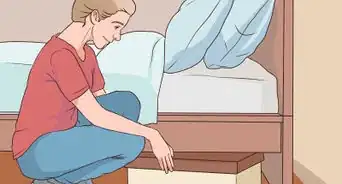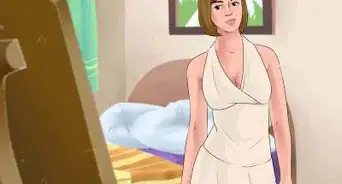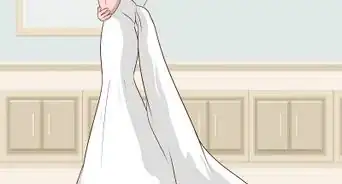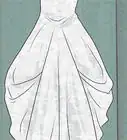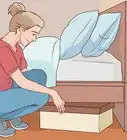This article was co-authored by Kpoene Kofi-Bruce. Kpoene Kofi-Bruce is a tailor, couture wedding gown designer, and the Creative Director of Mignonette Bridal and Ette the Wedding Tailor in Chicago, Illinois. With nearly two decades of experience as a wedding gown designer, small business owner, and vintage sewing enthusiast, Kpoene specializes in wedding gown design and the social history of wedding dresses. She received a BA in Creative Writing from Middlebury College and studied the business of fashion at the Fashion Institute of Technology. She is also a graduate of the Goldman Sachs 10KSB program and the Chicago Fashion Incubator and has written about wedding fashion for Jezebel, Catalyst, the Sun Times, and XO Jane.
wikiHow marks an article as reader-approved once it receives enough positive feedback. In this case, 85% of readers who voted found the article helpful, earning it our reader-approved status.
This article has been viewed 240,548 times.
Many women picture their wedding dress from the time they are very young. Sometimes, that picture doesn’t translate to a dress ready for purchase at the time of their wedding. Luckily, you can make your wedding dress to be as unique and as close to your dream dress as it can be. If you want to include some of the fabric from your mother’s dress for “something borrowed,” this is a great way to do so. This process takes vision and time, but makes for a one-of-a-kind dress on your big day.
Steps
Preparing your Dress
-
1Determine the basic shape of your dress. There are many wedding dress shapes. You may have pictured one that doesn’t work for your body. The best way to find that out is to go try on some wedding dresses.[1] Tell them that you wish to try on every shape in order to decide on just one.[2]
- Apple body: empire waistlines, A-line silhouettes
- Pear body: ball gown, A-line silhouettes
- Rectangle body: mermaid, empire waist
- Hourglass body: natural waistline, added waistline accents
-
2Consider other factors. Flattering your body is the most important part of choosing the right shape for you. Other aspects go into your decision. They can help lead you toward the right fabric for your dress as well.
- Location of the wedding is important. If you’re on the beach, you want a soft, light, and flowy shape and fabric. If you’re having a wedding in a grand cathedral, consider the season along with how much you want to stand out on your day in order to choose the shape and fabric.
- Determine your skill set. Some shapes and fabrics are more difficult to sew. If you’re new to sewing, choose a more basic shape and a fabric that allows for mistakes.
Advertisement -
3Choose your fabric. Find a material that you love and that you can work with. You may like the feel of a fabric but not the way it flows. The only way to be sure of this is to try dresses on in multiple fabrics, just like you did in multiple shapes. Of course, you can choose any fabric that you’d like, but there are popular fabrics for wedding dresses.[3]
- Chiffon: Delicate, sheer, and often layered
- Jersey: Elastic knit fabric, lengthwise and crosswise ribbing
- Moire: Heavy, silk taffeta, wavy design
- Organza: Crisp, sheer, stiffer texture
- Satin: Heavy, smooth, and high sheen
- Silk: Expensive, comes in multiple textures
- Taffeta: Crisp, smooth, slight ribbing
- Tulle: Netting made of silk, nylon, or rayon; used mostly for skirts and veils.
-
4Choose a color. Although standard wedding dresses are often labeled as “white,” there are multiple shades of white commonly used. Ivory, crème, off-white, pure white, stark white, and silk white are just a few. Find one that compliments your complexion.
-
5Sketch your dress. Now that you have a good idea of the shape you want and the fabric you’re going to use, draw out what you want your dress to look like. Sketch front and back, and sketch any details in a closer portion if needed.
Taking Measurements
-
1Ask a friend. Have someone else take your measurements. It is more accurate for someone else to do it rather than yourself. After sketching the shape that you want, be sure to label it with your measurements.
-
2Measure your bust. Measure at the fullest part of your chest. Be sure to wear the bra that you’ll wear on your wedding day when taking measurements. You should be wearing nothing on top of the bra.
-
3Measure your hips. Stand naturally with your heels together in a relaxed position. Measure the fullest part of your hip, being sure to go full circle.
-
4Measure your waist. This measurement should be at the natural curve of your waist. The smallest waist area is approximately 1” above your belly button. Don’t pull in your stomach unnaturally or pull the tape too tight.
-
5Measure hollow to hem. This is taken from right above the collarbone to where you want the bottom hem. Make sure to account for the shoes you’ll be wearing on your wedding day.
Choosing your Pattern
-
1Make your own sewing pattern. If you’re seasoned in making sewing patterns, you can make your own. Use your measurements to make your pattern, adding 1.5” for seam allowance. If you’ve never made your own pattern, a wedding dress is a very difficult pattern to begin with.
-
2Buy a sewing pattern. Once you have your fabric and style picked out, you can go to fabric stores and look through pattern books or you can order online. Each will be rated by level of difficulty.[4]
- Make sure that a key/glossary, layout, and step-by-step instructions are included.
- When you order your pattern, it is easy to combine multiple sizes to get the pattern as close to your measurements as possible.
- It's a good idea to get a few different sewing patterns so you can experiment with the fit you like best.[5]
-
3Use the right material. Patterns can be printed on a variety of materials. For example, it can be printed on large pieces of tissue paper, or stiffer white paper. The stiffer paper is better if you’ll be using it a lot. If you decide on tissue paper, make an extra pattern, just in case something happens to the original.
Follow your Pattern
-
1Buy your fabric. Now that you have your patterns, you’ll have the exact measurements that you’ll need to construct your dress. Go to the fabric store and pick up your fabric.
- If you’re going to use lace, you’ll want a base fabric. You’ll attach the lace overlay over this base layer.
- Some fabrics will be on special order. As soon as you decide on your fabric, make sure to ask if you need to special order it or if it will be available the day of.
- Consider buying an inexpensive fabric that you can practice on before you cut into your wedding dress fabric.[6]
-
2Cut your fabric. Lay the pieces of your pattern onto your fabric and pin it down with straight pins. Follow along the side of the pattern to cut out your fabric pieces into the right size and shape for your dress. Do this with the inside of your fabric facing up.
- If you plan on adding pleats to your dress, make sure to cut extra fabric.
-
3Pin the fabric together. Once all of your fabric pieces have been cut, pin them together (inside out). Keep your pins along the 1.5” of seam allowance from your pattern. Use a sewing model form to help you visualize the fit of the dress as you put it together.
- Opt for an adjustable dress form so you can set it to your basic measurements.[7]
Sewing your Dress
-
1Add texture to your dress. Fabric is flat. Once your fabric is pinned together, fold, bend, and gather it to accommodate for the curves of your body. If you plan on pleating the skirt, pin it to hold the pleats and sew over the pins. You can pull the pins out later.
-
2Follow the pattern. Sew the seams by following the shape that you cut out according to your pattern.
- Use vertical princess seams. These seams go from the top to the bottom. It is impossible to make a one piece dress without vertical princess seams. The fabric cut should reflect that, if not, you may want to pick another pattern to follow.
-
3Sew all the way to the hem. Even if you have extra fabric on the bottom or sides of your dress, follow the pattern strictly. It was designed in your size and your dress can be taken in much more easily than taken out once it’s been sewn.
-
4Try the dress on. Once again, you’ll want help. Once you’ve sewed all of your seams, gathers, and darts, try your dress on. Make any adjustments you need to in order to get the proper fit. Have your friend pin these adjustments for you.
-
5Sew your adjustments. Take the dress off and sew over the pins to make the necessary adjustments to your dress. Now is also the time to add embellishments. If you have a jeweled belt, lace applique, or any other embellishments, add them to your dress as the finishing touch.[8]
-
6Finish it off. Cut any loose strings, make one more round of adjustments, or sew something blue into the inside of your dress if you need to. After this, it’s ready for your big day.
- Follow care instructions provided with the fabric.
Expert Q&A
-
QuestionHow do I know what type of wedding gown will look best on me?
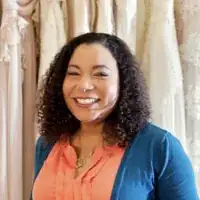 Kpoene Kofi-BruceKpoene Kofi-Bruce is a tailor, couture wedding gown designer, and the Creative Director of Mignonette Bridal and Ette the Wedding Tailor in Chicago, Illinois. With nearly two decades of experience as a wedding gown designer, small business owner, and vintage sewing enthusiast, Kpoene specializes in wedding gown design and the social history of wedding dresses. She received a BA in Creative Writing from Middlebury College and studied the business of fashion at the Fashion Institute of Technology. She is also a graduate of the Goldman Sachs 10KSB program and the Chicago Fashion Incubator and has written about wedding fashion for Jezebel, Catalyst, the Sun Times, and XO Jane.
Kpoene Kofi-BruceKpoene Kofi-Bruce is a tailor, couture wedding gown designer, and the Creative Director of Mignonette Bridal and Ette the Wedding Tailor in Chicago, Illinois. With nearly two decades of experience as a wedding gown designer, small business owner, and vintage sewing enthusiast, Kpoene specializes in wedding gown design and the social history of wedding dresses. She received a BA in Creative Writing from Middlebury College and studied the business of fashion at the Fashion Institute of Technology. She is also a graduate of the Goldman Sachs 10KSB program and the Chicago Fashion Incubator and has written about wedding fashion for Jezebel, Catalyst, the Sun Times, and XO Jane.
Couture Bridal Designer I always recommend going shopping first. Try on different styles and silhouettes to see what looks best on you before you start making your gown—you might surprise yourself!
I always recommend going shopping first. Try on different styles and silhouettes to see what looks best on you before you start making your gown—you might surprise yourself! -
QuestionWhat tools do I need to sew my own gown?
 Kpoene Kofi-BruceKpoene Kofi-Bruce is a tailor, couture wedding gown designer, and the Creative Director of Mignonette Bridal and Ette the Wedding Tailor in Chicago, Illinois. With nearly two decades of experience as a wedding gown designer, small business owner, and vintage sewing enthusiast, Kpoene specializes in wedding gown design and the social history of wedding dresses. She received a BA in Creative Writing from Middlebury College and studied the business of fashion at the Fashion Institute of Technology. She is also a graduate of the Goldman Sachs 10KSB program and the Chicago Fashion Incubator and has written about wedding fashion for Jezebel, Catalyst, the Sun Times, and XO Jane.
Kpoene Kofi-BruceKpoene Kofi-Bruce is a tailor, couture wedding gown designer, and the Creative Director of Mignonette Bridal and Ette the Wedding Tailor in Chicago, Illinois. With nearly two decades of experience as a wedding gown designer, small business owner, and vintage sewing enthusiast, Kpoene specializes in wedding gown design and the social history of wedding dresses. She received a BA in Creative Writing from Middlebury College and studied the business of fashion at the Fashion Institute of Technology. She is also a graduate of the Goldman Sachs 10KSB program and the Chicago Fashion Incubator and has written about wedding fashion for Jezebel, Catalyst, the Sun Times, and XO Jane.
Couture Bridal Designer You'll need quality fabric scissors, an adjustable dress form that can be set to your basic measurements, different sizes of needles and sewing feet—and time and patience!
You'll need quality fabric scissors, an adjustable dress form that can be set to your basic measurements, different sizes of needles and sewing feet—and time and patience! -
QuestionWhere can I buy lace fabric to make a wedding dress?
 Community AnswerMost fabric stores will have a Bridal or Special Occasions section with silks, sheer fabrics and lace. Another option is to buy online. Look for an online store that is willing to send samples, sometimes for a small fee, so that you can first confirm that the it feels and looks like you really want.
Community AnswerMost fabric stores will have a Bridal or Special Occasions section with silks, sheer fabrics and lace. Another option is to buy online. Look for an online store that is willing to send samples, sometimes for a small fee, so that you can first confirm that the it feels and looks like you really want.
References
- ↑ Kpoene Kofi-Bruce. Couture Bridal Designer. Expert Interview. 28 January 2021.
- ↑ https://www.preownedweddingdresses.com/dresses/by-shape
- ↑ https://www.theknot.com/content/wedding-gown-fabric-glossary
- ↑ http://www.tillyandthebuttons.com/2013/02/how-to-select-your-sewing-pattern-size.html
- ↑ Kpoene Kofi-Bruce. Couture Bridal Designer. Expert Interview. 28 January 2021.
- ↑ Kpoene Kofi-Bruce. Couture Bridal Designer. Expert Interview. 28 January 2021.
- ↑ Kpoene Kofi-Bruce. Couture Bridal Designer. Expert Interview. 28 January 2021.
- ↑ http://www.glitzonline.com/c/Lace_Appliques_Trim.html
About This Article
To make a wedding dress, start by choosing a fabric, such as satin, chiffon, or taffeta, and looking online for fabric patterns that are appropriate for your skill level. Next, pin your patterns over your fabric to cut out your fabric pieces, then sew them together according to the instructions in your pattern packet. Once you’ve finished sewing, try on the dress so you can make any adjustments to get the perfect fit. Then, sew on the embellishments, like lace applique or rhinestone beads, and finish your dress by cutting any loose strings. To learn more, like how to choose a wedding dress shape that flatters your figure, read on!
